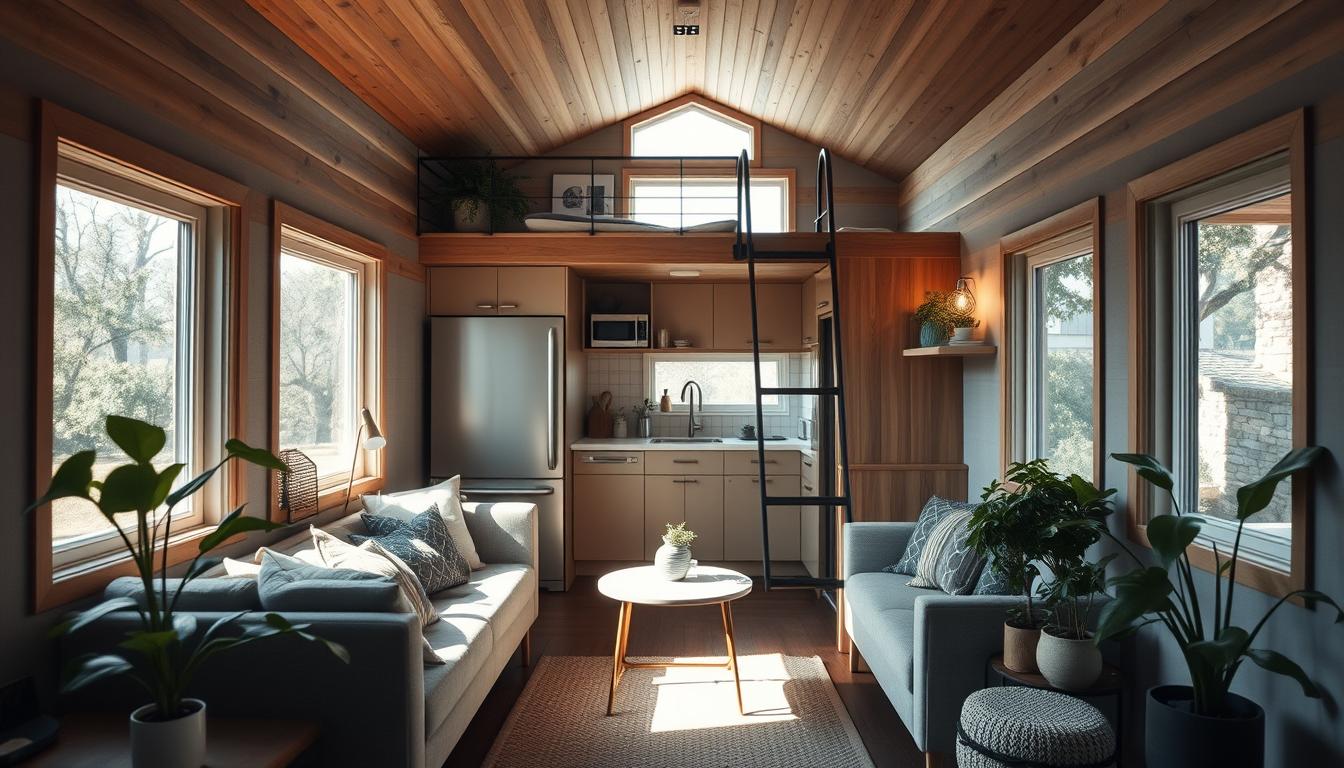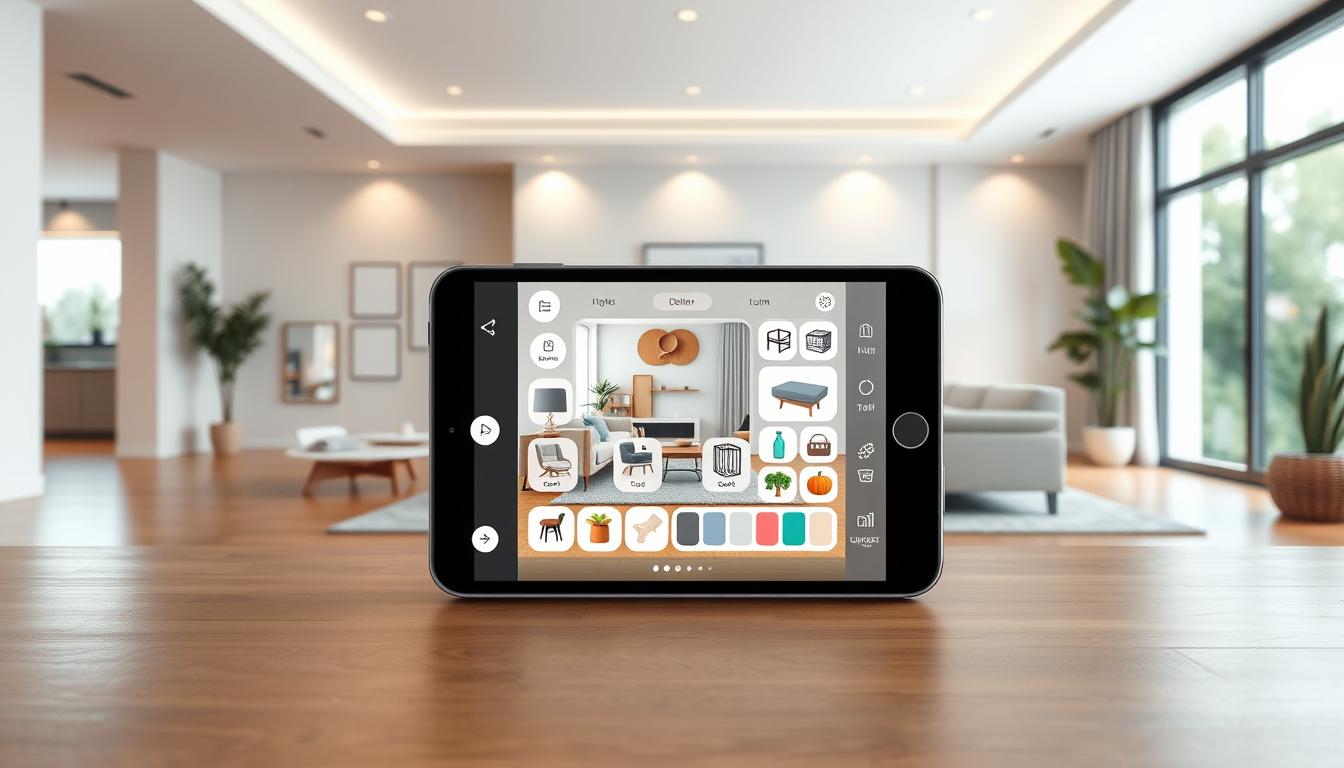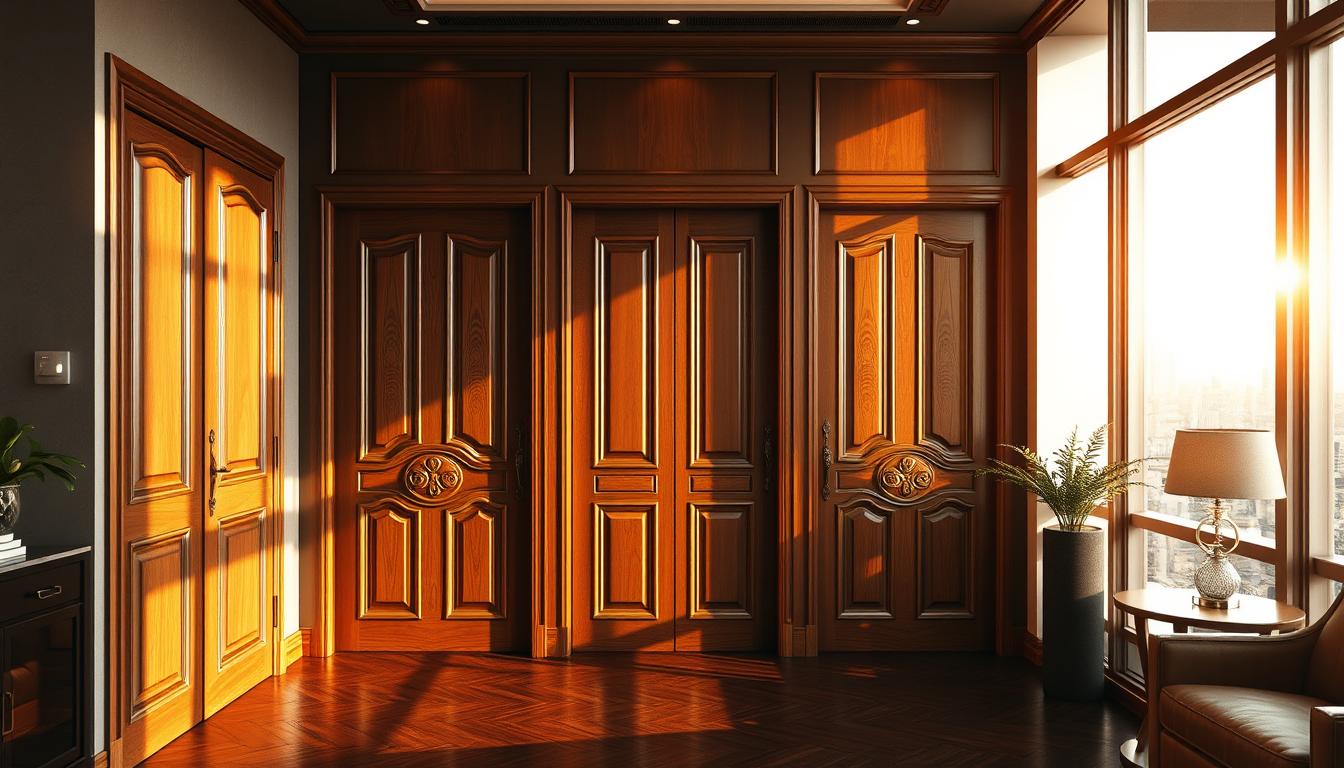Did you know over 10,000 people in the U.S. live in tiny homes? They choose a simpler, more sustainable life. As the tiny home movement grows, so does the need for creative, functional designs. We’ll explore how to make a tiny home interior beautiful and useful, focusing on space and design.
In this guide, we’ll show you how to make your small space cozy and efficient. Whether you’re already living tiny or thinking about it, we’ve got inspiration and practical tips for you.
Key Takeaways
- Maximizing space in small homes
- Creating a cohesive design
- Practical tips for tiny home interiors
- Inspiration for downsizing
- Efficient living area solutions
Understanding the Tiny Home Movement
The tiny home movement is gaining popularity. It focuses on minimalist living and caring for the environment. It’s not just about downsizing. It’s a lifestyle that values simplicity, sustainability, and efficiency.
Many people are drawn to the tiny home movement. It offers a streamlined and eco-friendly way of living. It challenges old ideas about homeownership and makes us think about what’s truly essential.
What is a Tiny Home?
A tiny home is usually under 400 square feet. They are designed to be space-efficient, with multi-functional furniture and smart storage. You can find tiny homes on wheels or fixed on land.
There’s a wide range of tiny home designs. They can be modern or cozy, reflecting the owner’s style in a small space.
Benefits of Tiny Living
Living in a tiny home has many advantages. It can save money, reduce environmental impact, and offer mobility. It also promotes a simpler way of life, focusing on what truly matters.
| Benefit | Description |
|---|---|
| Financial Savings | Lower utility bills, reduced maintenance costs, and decreased property taxes. |
| Environmental Impact | Smaller homes require fewer resources to build and maintain, reducing their environmental footprint. |
| Lifestyle Simplification | By living with fewer possessions, individuals can focus on experiences and personal growth. |
Common Misconceptions
Despite its popularity, the tiny home movement is often misunderstood. One common myth is that tiny homes are cheap. While they can be more affordable, the cost depends on size, materials, and custom features.
Another myth is that tiny homes aren’t good for families or long-term living. But, many families have made tiny homes work for them. With careful planning, tiny homes can meet long-term needs.
Key Principles of Tiny Home Design
Designing a tiny home is about using space wisely without losing style. There are key principles to follow. They help make your tiny home both useful and beautiful.
Maximizing Space
One big challenge is making the most of small space. Using multi-functional furniture and smart storage helps a lot. For example, a sofa bed or a storage ottoman can make your home more useful. For more tips, check out our website: Luxe Interior Co.
Functionality Over Aesthetics
In tiny home design, being practical is more important than looks. It doesn’t mean your home can’t look great. But every choice should be made with practicality in mind. For instance, picking colors that make the space feel bigger is key.
Cohesive Design
A tiny home needs a unified look since areas blend together. To achieve this, pick a color scheme, materials, and textures that match. This creates a sense of unity and makes the space seem bigger.
| Design Principle | Key Strategies | Benefits |
|---|---|---|
| Maximizing Space | Multi-functional furniture, clever storage | Increased functionality, reduced clutter |
| Functionality Over Aesthetics | Practical design choices, color schemes that enhance space | Enhanced usability, perceived larger space |
| Cohesive Design | Unifying color scheme, consistent materials, harmonious textures | Visual continuity, perceived larger space |
Choosing the Right Layout
Designing an efficient tiny home design begins with picking the right layout. The layout of your tiny home is key to its functionality and livability.
When picking a layout, think about how you want to use your space. Do you like an open feel or separate areas for different activities? Let’s look at the pros and cons of different layouts to help you decide.
Open Concept Versus Defined Spaces
An open concept layout can make your tiny home feel bigger. It allows for better airflow and natural light. But, it might lack privacy and clear areas for different activities.
Defined spaces, on the other hand, offer privacy and organization. But, they can feel cramped if not planned well.
“The way we live is a reflection of our priorities, and in a tiny home, every decision counts.”
Multi-Functional Areas
Adding multi-functional areas is crucial for an efficient tiny home design. For instance, a dining table can also be a workspace, or a sofa can turn into a bed. This way, you make the most of your space.
Flow and Accessibility
It’s important to ensure a smooth flow and accessibility in your tiny home. You should be able to move easily from one area to another without feeling cramped.
Think about the path you’ll take through your home. Place furniture and fixtures to make movement easy. Leave enough space between things for a comfortable and easy-to-navigate home.
By planning your layout carefully, you can create a cozy tiny home that feels spacious and is very functional.
Selecting Materials and Finishes
In tiny homes, materials and finishes do more than look good. They help make the space sustainable and durable. The right picks can change how the home feels and works.
Sustainable Options
There are many eco-friendly choices for tiny home materials and finishes. Eco-friendly materials like reclaimed wood, bamboo, and low-VOC paints are great. They’re good for the planet and improve indoor air quality.
Some top sustainable materials include:
- Reclaimed wood for flooring and walls
- Bamboo for furniture and decor
- Low-VOC paints for walls and ceilings
- Recycled metal for roofing and decor
Aesthetic Choices
The look of a tiny home depends a lot on materials and finishes. Light-colored materials can make a space seem bigger. Dark colors can make it feel cozy. Your choice should match the mood you want and the natural light.
| Material | Aesthetic Effect | Sustainability |
|---|---|---|
| Reclaimed Wood | Warm, rustic look | Highly sustainable |
| Bamboo | Light, modern appearance | Very sustainable |
| Low-VOC Paints | Variety of colors, smooth finish | Environmentally friendly |
Durability Considerations
Durability is key in tiny home design because of the small space. Materials and finishes need to last through daily use. Durable materials like hardwood flooring and stainless steel appliances are best for busy areas.
Choosing materials and finishes requires balancing looks, durability, and sustainability. This way, you can have a tiny home that’s not just pretty but also practical and green.
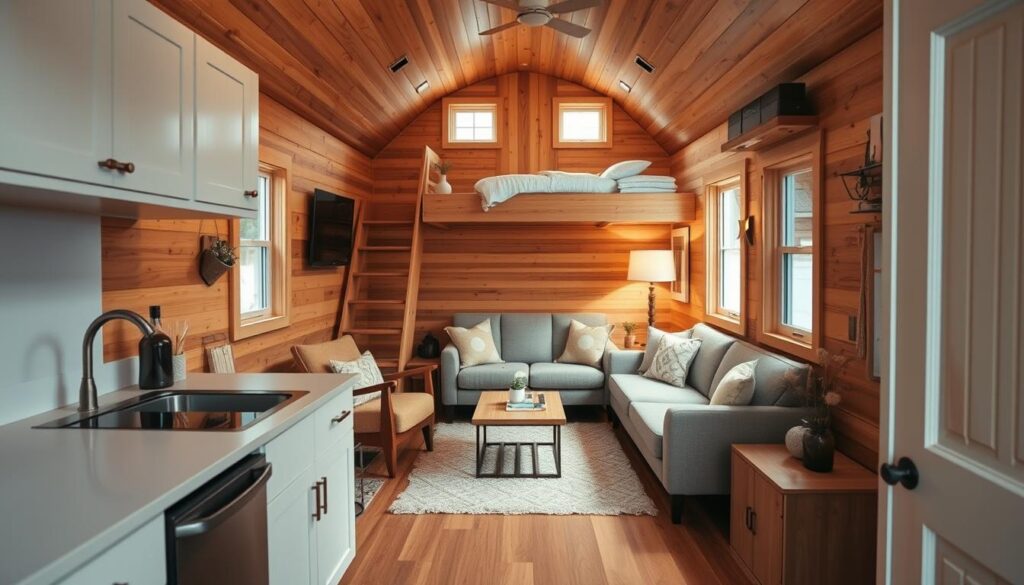
Color Schemes for Small Spaces
In the world of minimalist living, colors are key to making small spaces feel bigger and more welcoming. The right colors can turn a tiny home into a cozy retreat.
Light and Bright Colors
Light and bright colors on walls and ceilings can trick the eye into seeing more space. White, cream, and light gray are favorites for tiny homes. They reflect light and make rooms appear larger.
Adding soft pastels or pale tones can bring a personal touch. But, keep the colors light to keep the space feeling open.
Accent Walls
Light colors make spaces feel bigger, but an accent wall adds depth. Pick a bold color that fits with the rest of your decor. This adds personality and creates a focal point, distracting from the room’s size.
For ideas on mixing colors, check out our top home color combination ideas. They can help you choose the perfect accent wall color.
Seasonal Palette Updates
Changing your colors with the seasons keeps your tiny home lively. In spring and summer, go for lighter, brighter colors. In autumn and winter, warm, deeper tones create coziness.
This way, you can update your decor without big changes. It keeps your home vibrant and inviting, no matter the season.
Essential Furniture for Tiny Homes
Finding the right furniture for a tiny home is key to a cozy and useful space. It’s a challenge to pick pieces that are both useful and look good, without taking up too much room.
To solve this, focus on space-saving solutions that make the most of every inch. Choosing furniture that can do more than one thing is a smart move.
Space-Saving Solutions
Multi-functional furniture is a big help in tiny homes. Here are some examples:
- Sofa beds that double as guest beds
- Storage ottomans that provide a place to sit and store items
- Nesting tables that can be easily stowed away when not in use
These items save space and help keep your home tidy.
Custom Furniture Options
For a more personal touch, custom furniture can be made to fit your tiny home perfectly. This includes:
- Custom-built storage units that use every bit of space
- Tailored seating that fits snugly into corners or against walls
- Bespoke dining tables that can be adjusted or folded away
Custom furniture makes sure every inch of your home is used well for both function and comfort.
Versatile Seating Arrangements
Seating in a tiny home should be flexible and adaptable. Think about:
- Modular sofas that can be rearranged for different events
- Stools or poufs that can be moved or stored easily
- Built-in benches with storage underneath
| Furniture Type | Space-Saving Potential | Customization Options |
|---|---|---|
| Sofa Beds | High | Moderate |
| Storage Ottomans | High | High |
| Nesting Tables | High | Low |
By picking and arranging furniture wisely, you can make a tiny home that’s both useful and welcoming. The key is to think about what you need, use your space well, and choose furniture that does more than one thing.
Lighting Strategies for Tiny Interiors
Lighting is crucial in tiny homes to make them warm and efficient. It greatly affects the feel and function of a tiny home. Good lighting can make it feel bigger and more welcoming.
Enhancing Natural Light
Maximizing natural light is key in tiny homes. It cuts down on the need for artificial light and makes spaces feel open. To boost natural light, try:
- Large windows and skylights to let in more sunlight
- Light-colored window treatments that allow sunlight to filter through
- Mirrors strategically placed to reflect natural light into darker areas
These steps can make your tiny home brighter and more spacious.
Creating Layered Lighting Effects
Layered lighting uses different light sources for a good look and function. In tiny homes, this means:
- Ambient lighting: General lighting for the whole space
- Task lighting: Focused lighting for tasks like reading or cooking
- Accent lighting: Decorative lighting to highlight features or areas
Layering these lights creates a cozy and inviting tiny home atmosphere.
Energy-Efficient Lighting Choices
In tiny homes, saving energy is important. The right lighting can help. Consider:
- LED bulbs, which save energy and last longer
- Smart lighting systems that can be controlled and adjust based on use
- Dimmer switches to adjust light levels and save energy
Choosing energy-efficient lighting reduces your environmental impact and saves money on bills.
In summary, good lighting strategies are vital for tiny home interiors. They improve both space and energy use. By using natural light, layering lights, and picking energy-saving options, you can create a cozy tiny home that’s both functional and welcoming.
Storage Solutions in Tiny Homes
Keeping a tiny home tidy is key. Every inch matters, and smart storage can greatly improve living space. It makes the home more functional and comfortable.
Smart Storage Hacks
Smart storage hacks are a great way to make the most of tiny home space. Use under-bed containers, shelves that also divide rooms, and hidden spots in furniture.
For example, a storage ottoman can hold linens or winter clothes. A wall-mounted desk with storage keeps office supplies tidy and saves floor space.
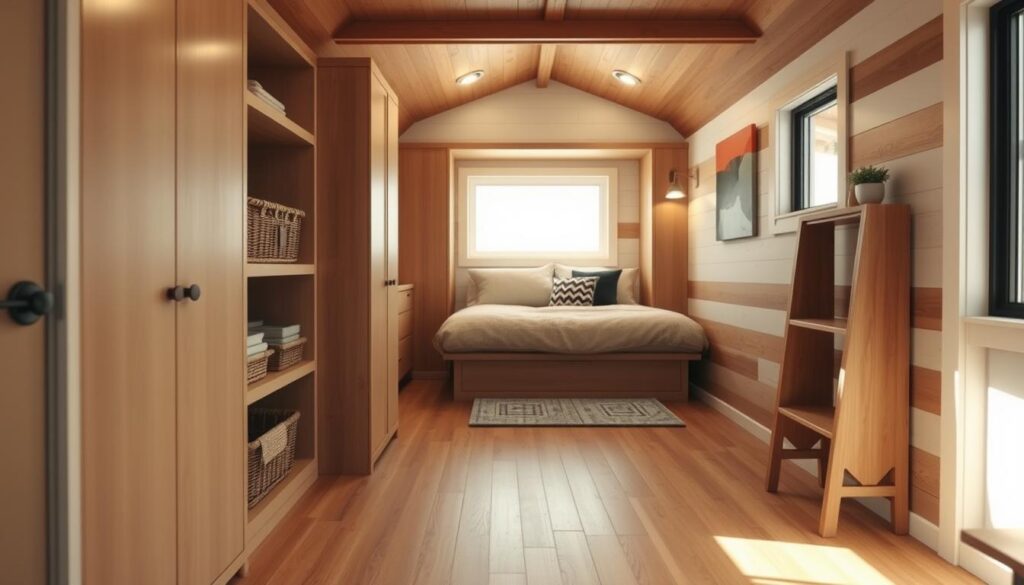
Hidden Spaces
Hidden spaces add a fun twist to tiny home storage. Think hidden cabinets, secret drawers, and hidden shelves.
A mirror that swings open to reveal a hidden spot is a clever idea. It adds surprise and makes the space more interesting.
Utilizing Vertical Space
Using vertical space is crucial in tiny homes. Tall shelves, stackable containers, and wall-mounted items help use every inch.
By using ceiling height, you can keep things organized and within reach. This keeps the floor clear and clutter-free.
| Storage Solution | Description | Benefits |
|---|---|---|
| Under-bed storage | Containers or drawers stored under the bed | Maximizes floor space, keeps items out of the way |
| Wall-mounted shelves | Shelves attached directly to the wall | Saves floor space, provides additional storage |
| Hidden compartments | Secret storage areas within furniture or walls | Adds security, keeps valuables safe |
By using these storage ideas, tiny home dwellers can enjoy a more organized and spacious home. Whether it’s smart hacks, hidden spots, or vertical use, there are many ways to improve a tiny home’s functionality.
Adding Personal Touches
Personal touches can make a tiny home feel like home. They add character and show off your style. This makes your tiny home truly yours.
Adding artwork and decor is a simple way to personalize your space. Choose items that speak to you. For example, vintage maps or family photos can add a unique touch.
Artwork and Decor
When picking artwork and decor, balance looks with function. Choose items that are pretty and useful. A storage ottoman can add style and storage.
Here’s a table with popular decor styles and what they’re all about:
| Decor Style | Characteristics |
|---|---|
| Minimalist | Simple, monochromatic, functional |
| Bohemian | Eclectic, colorful, layered |
| Coastal | Light, airy, nautical elements |
Plants and Greenery
Adding plants and greenery is a great way to personalize your home. They clean the air and make your space feel cozy. Start with easy plants like succulents.
Family Heirlooms and Sentimental Items
Displaying family heirlooms and sentimental items adds a special touch. They share your story and connect you to your past. Show them off on shelves or in shadow boxes.
With these personal touches, your tiny home becomes a warm, inviting space. It truly feels like home.
Creating Inviting Outdoor Spaces
Outdoor spaces can make our tiny homes more livable and appealing. By designing a welcoming outdoor area, we can expand our living space. This creates a smooth transition between inside and outside.
Balconies and Patios
For tiny homes with balconies or patios, we can make a cozy spot. Choose the right outdoor furniture and decor. Adding plants and greenery brings in a natural touch and makes the space feel bigger.
Outdoor Furniture Selection
When picking outdoor furniture, focus on function and comfort. Look for pieces that do more than one thing, like storage ottomans or benches with built-in planters.
Landscaping Tips
Landscaping is key to our tiny home’s look. Use native plants and flowers for a low-maintenance, beautiful landscape. This complements our cozy tiny home perfectly.
By adding these elements, we can make an inviting outdoor space. This boosts our tiny home’s livability and charm.

